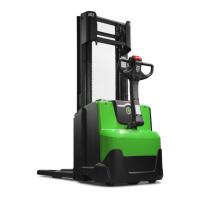
Do you have a question about the CESAB S210 and is the answer not in the manual?
Provides essential safety guidelines for performing work on the truck, emphasizing a clean site and correct posture.
Details safety precautions when working on the truck's electrical system, including handling tools and disconnecting the battery.
Covers safe lifting procedures for the truck, emphasizing stable surfaces, correct lifting points, and preventing tipping.
Covers service parameters (101-1000) used to adapt truck performance and response, requiring a CAN service key.
Covers service parameters related to hydraulic functions, including lowering speed and startup modes.
Covers safe lifting procedures for the truck, emphasizing center of gravity, indicated lifting points, and preventing tipping.
Guides on installing the correct size battery, checking electrolyte level, connecting cables, and safety precautions.
Explains the use of PIN codes for linking operator experience levels and truck characteristics into operator profiles.
Describes the special PIN code required for resetting the truck after a collision, and its programming by a technician.
Details two methods for programming PIN codes: using TruckCom or the truck keypad, including code limitations.
Provides a step-by-step guide for programming PIN codes, including restoring factory settings and activating/deactivating blocks.
Covers parameters set during truck commissioning, referring to the Parameters chapter for detailed descriptions.
Lists essential inspection points and procedures to be checked before putting the truck into use.
Provides instructions for routine maintenance, focusing on cleaning and washing as key factors for reliability.
Outlines maintenance intervals (750 operating hours or 12 months) and notes that the order is sorted by C codes.
Provides instructions for towing a defective truck, emphasizing operator presence, load removal, and safety precautions.
Explains how to activate emergency travel mode for moving the truck at low speed (1.3 km/h) when immobile.
Explains how to display and log the most recent error code events, showing codes chronologically with hour meter readings.
Explains the structure of error codes (X.YZZ), where X indicates the affected truck system and YZZ is a sequential number.
Lists specific error codes, their descriptions, truck behavior, causes, and recommended procedures for resolution.
Organizes troubleshooting into groups based on truck symptoms like 'cannot be driven' or 'behaves abnormally'.
Provides a chart detailing symptoms, influencing elements, and possible causes for the truck not being able to be driven.
Details symptoms, influencing elements, and possible causes for the truck operating at a reduced speed.
Lists symptoms, influencing elements, and possible causes for abnormal truck behavior while still drivable.
Addresses issues where the truck is drivable but specific functions are not working, including software and hardware compatibility.
Troubleshoots common hydraulic function failures, such as forks not raising or lowering, detailing symptoms and causes.
Introduces the service information mode for troubleshooting, detailing its activation and use for testing truck functions.
Provides a procedure to activate and perform built-in tests for the tiller arm functions like display, speed control, and safety reversing.
Details the steps for removing the motor, including cover removal, cable disconnection, and unscrewing retaining screws.
Illustrates and specifies the tightening torques for the drive motor mounting screws.
Details the steps for removing the drive gear from the truck, excluding the S212S model.
Provides instructions specifically for removing the drive gear from the S212S truck model.
Details the procedure for draining oil from the gear housing, including removing the plug and cleaning it.
Guides on removing the wheel hub seal, which involves removing the cover ring and the seal itself.
Details the process of replacing damaged or broken studs on the drive wheel hub, including methods for removal and applying Loctite.
Explains how to manually release the parking brake using screws for service or repair purposes.
Provides step-by-step instructions for removing the parking brake unit, including safety precautions and noting conduit entry position.
Details the process of fitting the parking brake, including torque tightening screws, fitting connectors, and installing dust caps.
Guides on checking the air gap of the parking brake after removal, emphasizing cleaning and maintaining a specific clearance.
Explains how to replace the drive wheel, including raising the truck, disassembling the wheel, and tightening nuts to specified torque.
Guides on replacing a castor wheel, emphasizing truck security, battery disconnection, and refitting the wheel and connections.
Guides on removing the tiller arm, including cover removal, disconnecting cable clamps, and cutting cable ties.
Details the process for replacing a gas strut, involving cover removal, unscrewing, and detaching the strut.
Outlines the removal steps for the safety sensor, including removing the gas strut, stop screw, and indicator sleeve.
Details the procedure for replacing the logic card, emphasizing static electricity precautions and steps for removal and installation.
Details the procedure for replacing the transistor regulator, requiring TruckCom access for configuration and parameter reset.
Explains the hydraulic calibration function used to handle proportional valve tolerance, requiring service mode 'cal' and a service key.
Guides on adjusting the pressure limiting valve to ensure the truck can handle rated loads, with steps for clockwise and counter-clockwise adjustment.
Guides on replacing the fork carriage, involving lifting the carriage, removing the chain bolt, and lowering the carriage.
Details the process for replacing the mast, including disconnecting fork carriage, connectors, and removing the spiral hose.
Covers mast adjustment after replacement, emphasizing checking truck levelness and fitting shims as needed.
Warns about the high internal pressure of gas struts and provides instructions for safe disassembly, including wearing safety goggles.
Presents a general wiring diagram of the truck's electrical system, illustrating connections between various components.
Shows a detailed wiring diagram illustrating connections for motor control, sensors, and CAN communication.